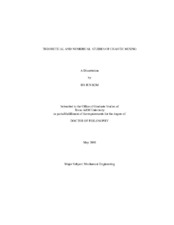| dc.description.abstract | Theoretical and numerical studies of chaotic mixing are performed to circumvent the difficulties
of efficient mixing, which come from the lack of turbulence in microfluidic devices. In order to
carry out efficient and accurate parametric studies and to identify a fully chaotic state, a spectral
element algorithm for solution of the incompressible Navier-Stokes and species transport
equations is developed. Using Taylor series expansions in time marching, the new algorithm
employs an algebraic factorization scheme on multi-dimensional staggered spectral element
grids, and extends classical conforming Galerkin formulations to nonconforming spectral
elements. Lagrangian particle tracking methods are utilized to study particle dispersion in the
mixing device using spectral element and fourth order Runge-Kutta discretizations in space and
time, respectively. Comparative studies of five different techniques commonly employed to
identify the chaotic strength and mixing efficiency in microfluidic systems are presented to
demonstrate the competitive advantages and shortcomings of each method. These are the stirring
index based on the box counting method, Poincare sections, finite time Lyapunov exponents, the
probability density function of the stretching field, and mixing index inverse, based on the
standard deviation of scalar species distribution. Series of numerical simulations are performed
by varying the Peclet number (Pe) at fixed kinematic conditions. The mixing length (lm) is characterized as function of the Pe number, and lm ∝ ln(Pe) scaling is demonstrated for fully
chaotic cases. Employing the aforementioned techniques, optimum kinematic conditions and the
actuation frequency of the stirrer that result in the highest mixing/stirring efficiency are
identified in a zeta potential patterned straight micro channel, where a continuous flow is
generated by superposition of a steady pressure driven flow and time periodic electroosmotic
flow induced by a stream-wise AC electric field. Finally, it is shown that the invariant manifold
of hyperbolic periodic point determines the geometry of fast mixing zones in oscillatory flows in
two-dimensional cavity. | en |


